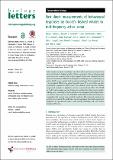Files in this item
First direct measurements of behavioural responses by Cuvier's beaked whales to mid-frequency active sonar
Item metadata
| dc.contributor.author | De Ruiter, Stacy Lynn | |
| dc.contributor.author | Southall, Brandon L. | |
| dc.contributor.author | Calambokidis, John | |
| dc.contributor.author | Zimmer, Walter M. X. | |
| dc.contributor.author | Sadykova, Dinara | |
| dc.contributor.author | Falcone, Erin A. | |
| dc.contributor.author | Friedlaender, Ari S. | |
| dc.contributor.author | Joseph, John E. | |
| dc.contributor.author | Moretti, David | |
| dc.contributor.author | Schorr, Gregory S. | |
| dc.contributor.author | Thomas, Len | |
| dc.contributor.author | Tyack, Peter Lloyd | |
| dc.date.accessioned | 2013-07-09T12:01:01Z | |
| dc.date.available | 2013-07-09T12:01:01Z | |
| dc.date.issued | 2013 | |
| dc.identifier | 57868566 | |
| dc.identifier | 7877190c-cb09-40ad-8f1a-65e2d8a65497 | |
| dc.identifier | 84880832292 | |
| dc.identifier.citation | De Ruiter , S L , Southall , B L , Calambokidis , J , Zimmer , W M X , Sadykova , D , Falcone , E A , Friedlaender , A S , Joseph , J E , Moretti , D , Schorr , G S , Thomas , L & Tyack , P L 2013 , ' First direct measurements of behavioural responses by Cuvier's beaked whales to mid-frequency active sonar ' , Biology Letters , vol. 9 , no. 4 , pp. 1-5 . https://doi.org/10.1098/rsbl.2013.0223 | en |
| dc.identifier.issn | 1744-9561 | |
| dc.identifier.other | ORCID: /0000-0002-7436-067X/work/29591691 | |
| dc.identifier.other | ORCID: /0000-0002-8409-4790/work/60887909 | |
| dc.identifier.uri | https://hdl.handle.net/10023/3836 | |
| dc.description.abstract | Most marine mammal strandings coincident with naval sonar exercises have involved Cuvier's beaked whales (Ziphius cavirostris). We recorded animal movement and acoustic data on two tagged Ziphius and obtained the first direct measurements of behavioural responses of this species to mid-frequency active (MFA) sonar signals. Each recording included a 30-min playback (one 1.6-s simulated MFA sonar signal repeated every 25 s); one whale was also incidentally exposed to MFA sonar from distant naval exercises. Whales responded strongly to playbacks at low received levels (RLs; 89–127 dB re 1 µPa): after ceasing normal fluking and echolocation, they swam rapidly, silently away, extending both dive duration and subsequent non-foraging interval. Distant sonar exercises (78–106 dB re 1 µPa) did not elicit such responses, suggesting that context may moderate reactions. The observed responses to playback occurred at RLs well below current regulatory thresholds; equivalent responses to operational sonars could elevate stranding risk and reduce foraging efficiency. | |
| dc.format.extent | 5 | |
| dc.format.extent | 995962 | |
| dc.language.iso | eng | |
| dc.relation.ispartof | Biology Letters | en |
| dc.subject | Acoustic disturbance | en |
| dc.subject | Avoidance response | en |
| dc.subject | Anthropogenic noise | en |
| dc.subject | Mid-frequency active sonar | en |
| dc.subject | Military | en |
| dc.subject | Ziphius cavirostris | en |
| dc.subject | QH301 Biology | en |
| dc.subject | SDG 14 - Life Below Water | en |
| dc.subject.lcc | QH301 | en |
| dc.title | First direct measurements of behavioural responses by Cuvier's beaked whales to mid-frequency active sonar | en |
| dc.type | Journal article | en |
| dc.contributor.sponsor | Office of Naval Research | en |
| dc.contributor.sponsor | Naval Facilities Engineeering | en |
| dc.contributor.institution | University of St Andrews. School of Mathematics and Statistics | en |
| dc.contributor.institution | University of St Andrews. Centre for Research into Ecological & Environmental Modelling | en |
| dc.contributor.institution | University of St Andrews. Statistics | en |
| dc.contributor.institution | University of St Andrews. Scottish Oceans Institute | en |
| dc.contributor.institution | University of St Andrews. Marine Alliance for Science & Technology Scotland | en |
| dc.contributor.institution | University of St Andrews. School of Biology | en |
| dc.contributor.institution | University of St Andrews. Sea Mammal Research Unit | en |
| dc.contributor.institution | University of St Andrews. Sound Tags Group | en |
| dc.contributor.institution | University of St Andrews. Bioacoustics group | en |
| dc.identifier.doi | 10.1098/rsbl.2013.0223 | |
| dc.description.status | Peer reviewed | en |
| dc.identifier.url | http://rsbl.royalsocietypublishing.org/content/9/4/20130223.full | en |
| dc.identifier.grantnumber | N00014-12-1-0204 | en |
| dc.identifier.grantnumber | en |
This item appears in the following Collection(s)
Items in the St Andrews Research Repository are protected by copyright, with all rights reserved, unless otherwise indicated.

